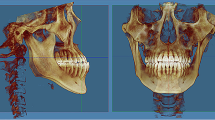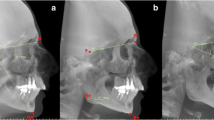Abstract
Objective
This study aimed to assess the morphology and location of the great palatine foramen (GPF) of different facial types using cone beam computed tomography (CBCT) scans.
Methods
Sixty CBCT scans were divided into: brachyfacial (n = 20), dolichofacial (n = 20) and mesofacial (n = 20) using Ricketts’ VERT index for the determination of cephalometric facial type and imported into ImageJ software. GPF shape was characterized as: round, elongated in the anteroposterior direction (EAP), or elongated in the latero-medial direction (ELM). The distances between the GPF and the palatine suture (PS), the center of the GPF and the center incisive foramen (IF), the GPF and the palatine alveolar ridge (PAR), right side GPF (GPFr) and left side (GPFl) GPFs; and the angles formed from the intersection of the GPF, IF and PS were assessed. The position of the GPF was evaluated in relation to the molars.
Results
GPFr and GPFl mean distances from PAR presented higher values for dolichofacial patients (p < 0.05). GPFr and GPFl location distally to the third molar (3 M) was higher for brachyfacial type, while their location distally to the second molar was higher for mesofacial and between the mesial and distal surfaces of the 3 M for dolichofacial (p < 0.05).
Conclusions
The GPF was more distant from the PAR in the dolichofacial-type group. The location of the GPF in relation to the molars varied according to the facial type. However, the morphology of the GPF was similar in the three facial types, and the elongated in the anteroposterior direction morphology was more frequent.


Similar content being viewed by others
References
Cagimni P, Govsa F, Ozer MA, Kazak Z. Computerized analysis of the greater palatine foramen to gain the palatine neurovascular bundle during palatal surgery. Surg Radiol Anat. 2017;39:177–84.
Helwany M, Rathee M. Anatomy, head and neck, palate. In: StatPearls. 2021. https://www.ncbi.nlm.nih.gov/books/NBK557817/. Accessed 02 Mar 2021.
Fonseka MCN, Hettiarachchi PVKS, Jayasinghe RM, Jayasinghe RD, Nanayakkara CD. A cone beam computed tomographic analysis of the greater palatine foramen in a cohort of Sri Lankans. J Oral Biol Craniofac Res. 2019;9:306–10. https://doi.org/10.1016/j.jobcr.2019.06.012.
Aoun G, Nasseh I, Sokhn S. Radio-anatomical study of the greater palatine canal and the pterygopalatine fossa in a lebanese population: a consideration for maxillary nerve block. J Clin Imaging Sci. 2016;6:1–7. https://doi.org/10.4103/2156-7514.190862.
Fu JH, Hasso DG, Yeh CY, Leong DJM, Chan HL, Wang HL. The accuracy of identifying the greater palatine neurovascular bundle: a cadaver study. J Periodontol. 2011;82:1000–6. https://doi.org/10.1902/jop.2011.100619.
Cantarella D, Dominguez-Mompell R, Mallya SM, Moschik C, Pan HC, Miller J, Moon W. Changes in the midpalatal and pterygopalatine sutures induced by micro-implant-supported skeletal expander, analyzed with a novel 3D method based on CBCT imaging. Prog Orthod. 2017;18:1–12. https://doi.org/10.1186/s40510-017-0188-7.
Tomaszewska IM, Tomaszewski KA, Kmiotek EK, Pena IZ, Urbanik A, Nowakowski M, Walocha JA. Anatomical landmarks for the localization of the greater palatine foramen–a study of 1200 head CTs, 150 dry skulls, systematic review of literature and meta-analysis. J Anat. 2014;225:419–35. https://doi.org/10.1111/joa.12221.
Huang X, Hu X, Zhao Y, Wang Y, Gu Y. Preliminary comparison of three-dimensional reconstructed palatal morphology in subjects with different sagittal and vertical patterns. BMC Oral Health. 2020;20:1–12. https://doi.org/10.1186/s12903-020-1041-9.
Monsour P, Huang T. Morphology of the greater palatine grooves of the hard palate: a cone beam computed tomography study. Aust Dent J. 2016;61:329–32. https://doi.org/10.1111/adj.12375.
Tavelli L, Barootchi S, Ravidà A, Oh TJ, Wang HL. What is the safety zone for palatal soft tissue graft harvesting based on the locations of the greater palatine artery and foramen? A systematic review. J Oral Maxillofac Surg. 2019;77:271.e1-271.e9. https://doi.org/10.1016/j.joms.2018.10.002.
Rapado-González O, Suárez-Quintanilla JA, Otero-Cepeda XL, Fernández-Alonso A, Suárez-Cunqueiro MM. Morphometric study of the greater palatine canal: cone-beam computed tomography. Surg Radiol Anat. 2015;37:1217–24. https://doi.org/10.1007/s00276-015-1511-y.
Bahşi İ, Orhan M, Kervancıoğlu P, Yalçın ED. Morphometric evaluation and clinical implications of the greater palatine foramen, greater palatine canal and pterygopalatine fossa on CBCT images and review of literature. Surg Radiol Anat. 2019;41:551–67. https://doi.org/10.1007/s00276-019-02179-x.
Dave MR, Yagain VK, Anadkat S. A study of the anatomical variations in the position of the greater palatine foramen in adult human skulls and its clinical significance. Int J Morphol. 2013;31:578–83. https://doi.org/10.4067/S0717-95022013000200036.
Hafeez NS, Sondekoppam RV, Ganapathy S, Armstrong JE, Shimizu M, Johnson M, Merrifield P, Galil KA. Ultrasound-guided greater palatine nerve block: a case series of anatomical descriptions and clinical evaluations. Anesth Analg. 2014;119:726–30. https://doi.org/10.1213/ANE.0000000000000329.
Soto RA, Cáceres F, Vera C. Morphometry of the greater palatal canal in adult skulls. J Craniofac Surg. 2015;26:1697–9. https://doi.org/10.1097/SCS.0000000000001600.
Gibelli D, Borlando A, Dolci C, Pucciarelli V, Cattaneo C, Sforza C. Anatomical characteristics of greater palatine foramen: a novel point of view. Surg Radiol Anat. 2017;39:1359–68. https://doi.org/10.1007/s00276-017-1899-7.
Sella Tunis T, May H, Sarig R, Vardimon AD, Hershkovitz I, Shpack N. Are chin and symphysis morphology facial type-dependent? A computed tomography-based study. Am J Orthod Dentofacial Orthop. 2021. https://doi.org/10.1016/j.ajodo.2020.03.031.
Alarcón JA, Velasco-Torres M, Rosas A, Galindo-Moreno P, Catena A. Relationship between vertical facial pattern and brain structure and shape. Clin Oral Investig. 2020;24:1499–508. https://doi.org/10.1007/s00784-020-03227-2.
Benedicto EN, Kairalla SA, Kajeda AK, Miranda SL, Torres FC, Paranhos LR. Determination of the vertical skeletal facial pattern. Rev Bras Cir Craniomaxilofac. 2011;14:44–9.
Ricketts RM. Orthodontic diagnosis and planning. USA: Rock Mountain Orthod; 1982.
Jaffar AA, Hamadah HJ. An analysis of the position of the greater palatine foramen. J Basic Med Sci. 2003;3:24–32.
Ikuta CR, Cardoso CL, Ferreira-Júnior O, Lauris JR, Souza PH, Rubira-Bullen IR. Position of the greater palatine foramen: an anatomical study through cone beam computed tomography images. Surg Radiol Anat. 2013;35:837–42. https://doi.org/10.1007/s00276-013-1151-z.
Methathrathip D, Apinhasmit W, Chompoopong S, Lertsirithong A, Ariyawatkul T, Sangvichien S. Anatomy of greater palatine foramen and canal and pterygopalatine fossa in Thais: considerations for maxillary nerve block. Surg Radiol Anat. 2005;27:511–6. https://doi.org/10.1007/s00276-005-0016-5.
Santana N, Starbuck JM. Breaking symmetry: a quantitative analysis of facial skeleton disharmony in children born with bilateral cleft lip and palate. Anat Rec (Hoboken). 2019;302:1726–32. https://doi.org/10.1002/ar.24111.
Sharma NA, Garud RS. Greater palatine foramen–key to successful hemimaxillary anaesthesia: a morphometric study and report of a rare aberration. Singapore Med J. 2013;54:152–9. https://doi.org/10.11622/smedj.2013052.
Saralaya V, Nayak SR. The relative position of the greater palatine foramen in dry Indian skulls. Singapore Med J. 2007;48:1143–6.
Costa ED, Peyneau PD, Ambrosano GMB, Oliveira ML. Influence of cone beam CT volume orientation on alveolar bone measurements in patients with different facial profiles. Dentomaxillofac Radiol. 2019;48:1–6. https://doi.org/10.1259/dmfr.20180330.
Renu C. The position of greater palatine foramen in the adult human skulls of North Indian origin. J Surg Acad. 2013;3:54–7.
Nimigean V, Nimigean VR, Buţincu L, Sălăvăstru DI, Podoleanu L. Anatomical and clinical considerations regarding the greater palatine foramen. Rom J Morphol Embryol. 2013;54:779–83.
Chrcanovic BR, Custódio AL. Anatomical variation in the position of the greater palatine foramen. J Oral Sci. 2010;52:109–13. https://doi.org/10.2334/josnusd.52.109.
Funding
The authors did not receive support from any organization for the submitted work.
Author information
Authors and Affiliations
Contributions
JTL-S: protocol/project development, data collection or management, data analysis and manuscript writing/editing. GLG: data collection or management, data analysis and manuscript writing/editing. GBF: data collection or management and manuscript writing/editing. LRCM: data collection or management. DPM: manuscript writing/editing and performed the final critical review. JAS: data collection or management, data analysis and manuscript writing/editing.
Corresponding author
Ethics declarations
Conflict of interest
All authors declare no conflicts of interest.
Ethics approval
All procedures followed were in accordance with the ethical standards of the responsible committee on human experimentation (Ethics Committee of University Center of Patos, approval date and number: 08 July 2016; #69003417.7.0000.5181) and with the Helsinki Declaration of 1975, as revised in 2008.
Informed consent
Not applicable.
Additional information
Publisher's Note
Springer Nature remains neutral with regard to jurisdictional claims in published maps and institutional affiliations.
Rights and permissions
About this article
Cite this article
Lacerda-Santos, J.T., Granja, G.L., de Freitas, G.B. et al. The influence of facial types on the morphology and location of the greater palatine foramen: a CBCT study. Oral Radiol 38, 337–343 (2022). https://doi.org/10.1007/s11282-021-00563-1
Received:
Accepted:
Published:
Issue Date:
DOI: https://doi.org/10.1007/s11282-021-00563-1




